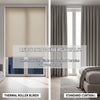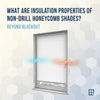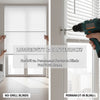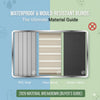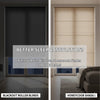The Ultimate Guide to Blinds: Styles, Materials, and Functions Explained
- by Mariam Labadze
Quick Answer
Window blinds encompass diverse styles serving specific functions: roller blinds offer simplicity and versatility, venetian blinds provide precise light control through adjustable slats, vertical blinds suit large windows and doors, Roman blinds deliver soft elegance, and cellular designs maximize energy efficiency. Materials range from moisture-resistant PVC and aluminum for bathrooms, natural wood for living spaces, durable faux wood for humid areas, to varied fabrics offering unlimited aesthetic possibilities. Functions include light control (sheer filtering to complete blackout), privacy management, energy efficiency through insulation, UV protection preserving furnishings, and noise reduction. Choosing appropriate blinds requires matching style to room aesthetics, material to environmental conditions, and function to specific needs—prioritizing moisture resistance in bathrooms, blackout capabilities in bedrooms, and energy efficiency throughout.
Roller Blinds: Simplicity and Versatility
Design Characteristics – Roller blinds feature single fabric pieces rolling onto tubes mounted above windows. This straightforward design creates clean, uncluttered appearances that suit contemporary interiors whilst the operational simplicity appeals to those valuing functionality over decorative complexity.
The minimalist profile works beautifully in compact spaces where bulkier treatments would overwhelm proportions. Roller blinds virtually disappear when raised, maximizing window transparency and natural light admission impossible with permanently visible treatment components.
Material Options – Fabric rollers span enormous variety from sheer voiles creating soft filtered light to complete blackout materials ensuring bedroom darkness. PVC rollers provide moisture resistance perfect for bathrooms and kitchens, whilst textured fabrics add visual interest supporting various aesthetic approaches.
Thermal-backed rollers combine standard roller simplicity with energy-efficient backing materials reflecting summer heat whilst retaining winter warmth. This functional enhancement adds minimal bulk whilst delivering measurable comfort and cost benefits.
Ideal Applications – Roller blinds suit virtually any room but excel in kitchens and bathrooms through moisture-resistant PVC options, whilst blackout versions perfect bedrooms requiring darkness. Home offices benefit from light-filtering rollers reducing screen glare whilst maintaining adequate brightness supporting productivity.
The variety allows coordinating roller blinds throughout homes in different opacities and materials addressing room-specific requirements whilst maintaining consistent aesthetic through unified style approach.
Venetian Blinds: Precision Light Control
Horizontal Slat Design – Venetian blinds feature horizontal slats suspended by cords or tapes, tilting to control light whilst raising or lowering for full adjustment range. This dual-control capability provides unmatched precision—angle slats for filtered privacy whilst maintaining natural light, or close completely for darkness and maximum privacy.
Slat widths typically range 25mm-50mm, with wider options creating more contemporary appearances whilst narrower slats suit traditional aesthetics. This proportional consideration affects both visual impact and light control granularity—more slats provide finer adjustment increments.
Material Choices – Aluminum venetians offer ultimate practicality through moisture resistance, easy cleaning, and affordability making them popular for bathrooms, kitchens, and budget-conscious whole-house applications. The metal durability ensures long service lives withstanding environments challenging other materials.
Real wood venetians deliver natural warmth and premium aesthetics suited to living rooms, dining areas, and master bedrooms where traditional elegance matters. However, moisture sensitivity restricts wood to dry locations avoiding the warping and deterioration that humidity causes.
Faux wood alternatives provide authentic wood aesthetics with superior moisture resistance, creating ideal solutions for bathrooms and kitchens where genuine timber fails whilst maintaining convincing appearances indistinguishable from real wood at normal viewing distances.
Best Uses – Venetian blinds work universally but particularly suit spaces requiring nuanced light control—home offices where glare management matters, living rooms balancing natural light with television viewing comfort, and bedrooms where occupants desire flexibility between filtered morning light and complete evening darkness.
Vertical Blinds: Solutions for Large Openings
Vertical Orientation – Individual slats hanging vertically from head rails rotate for light control whilst drawing to sides for full access. This design naturally accommodates wide windows and patio doors where horizontal treatments prove impractical or prohibitively expensive.
The vertical operation allows covering expansive glazing economically—substantial cost advantages compared to Roman blinds or curtains addressing equivalent areas. This efficiency makes vertical blinds popular for modern homes featuring floor-to-ceiling windows and large sliding doors.
Material Variations – Fabric vertical blinds provide softer aesthetics than rigid alternatives whilst vinyl options deliver moisture resistance and easy maintenance suited to high-traffic or humid locations. The material choice significantly affects both appearance and practical suitability for specific environments.
Wider 127mm slats create more contemporary appearances than traditional 89mm widths, improving aesthetic perceptions that previously dismissed vertical blinds as dated despite their practical advantages for certain applications.
Appropriate Applications – Vertical blinds excel on patio doors maintaining unobstructed access when opened, large picture windows where horizontal treatments prove impractical, and commercial applications requiring economical coverage of substantial glazed areas.
Contemporary homes with expansive windows benefit from vertical blinds' clean lines complementing modern architecture whilst budget realities make premium alternatives covering equivalent areas financially prohibitive.
Roman Blinds: Soft Elegance
Fabric Panel Construction – Roman blinds feature fabric panels folding into horizontal pleats when raised, creating elegant stacked appearances. When lowered, fabric hangs flat presenting patterns or textures across entire window surfaces—textile art enhancing spaces beyond purely functional coverage.
The soft fabric aesthetic suits traditional and transitional interiors where hard treatments feel too contemporary or industrial. Romans provide textile warmth that aluminum or PVC alternatives cannot replicate, creating inviting atmospheres in living spaces and bedrooms.
Style Variations – Flat Romans create clean contemporary folds, whilst hobbled styles feature permanent soft folds even when lowered, creating romantic, traditional appearances. Relaxed Romans present gentle curves rather than crisp pleats, offering casual elegance suited to country or cottage aesthetics.
This style variety allows tailoring Romans to specific interior design approaches—selecting flat styles for modern spaces, hobbled versions for traditional rooms, or relaxed options for transitional aesthetics.
Lining Options – Standard linings provide modest privacy and light control, thermal linings add insulation improving energy efficiency, and blackout linings ensure bedroom darkness. These functional layers enhance Romans beyond pure aesthetics, addressing practical requirements without compromising elegant appearances.
Ideal Locations – Roman blinds suit living rooms, dining areas, and master bedrooms where soft aesthetics and design impact matter. The fabric's acoustic benefits prove valuable in hard-surfaced rooms where sound damping improves comfort.
However, avoid Romans in bathrooms and kitchens where moisture causes mold, fabric absorbs cooking odors, and cleaning requirements prove impractical for busy households.
Cellular/Honeycomb Blinds: Energy Efficiency Champions
Honeycomb Structure – Distinctive cellular construction creates air pockets that trap heat, providing superior insulation compared to flat alternatives. Single-cell designs offer good thermal performance, whilst double-cell constructions essentially double insulating capacity through two trapped air layers.
This engineered efficiency makes cellular blinds the choice for energy-conscious households prioritizing reduced heating and cooling costs through improved window thermal performance—often the weakest point in home thermal envelopes.
Light Filtering Options – Sheer cellular fabrics provide excellent insulation whilst admitting natural daylight, reducing artificial lighting needs. Blackout versions offer maximum thermal performance alongside complete darkness valuable in bedrooms where both energy efficiency and sleep quality matter.
Applications – Cellular blinds suit any room but particularly benefit bedrooms through combined insulation and blackout capabilities. North-facing rooms losing substantial heat benefit from cellular treatments' superior thermal resistance, whilst sun-drenched south-facing spaces profit from solar heat rejection that sheer cellular fabrics provide.
The energy savings often justify premium pricing compared to basic alternatives—payback periods typically span 2-4 years through reduced utility bills whilst superior comfort proves harder quantifying but equally valuable.
Perfect Fit: No-Drill Innovation
Clip-On Frame System – Perfect Fit represents revolutionary no-drill approach featuring frames clipping directly onto uPVC window beading without screws or adhesive. Blinds operate within these frames sitting flush against glass, moving with windows when opened rather than remaining fixed to walls.
This innovative design suits rental properties requiring damage-free installation, tilt-and-turn windows where wall-mounted treatments prevent inward opening, and anyone preferring reversible installations avoiding permanent alterations.
Style Availability – Perfect Fit accommodates venetian, pleated, and roller styles within its frame system, providing reasonable variety addressing diverse aesthetic and functional preferences. Whilst selection proves narrower than traditional mounting options, coverage includes most common requirements.
Advantages – Beyond no-drilling benefits, Perfect Fit creates exceptionally neat integrated appearances that many find superior to traditional installations. The treatments appearing purposefully incorporated into window architecture rather than afterthought additions appeals to design-conscious homeowners.
Material Selection Guide
Moisture Resistance – PVC, aluminum, and faux wood excel in humid bathrooms and kitchens, resisting warping, mold, and deterioration that destroy fabric and real wood. This environmental compatibility proves crucial for longevity—matching materials to conditions prevents premature failure regardless of quality.
Aesthetic Warmth – Natural wood, fabric, and textured materials create welcoming atmospheres that hard synthetics cannot replicate. These materials suit living spaces, bedrooms, and areas where comfort and traditional elegance matter more than pure practicality.
Maintenance Requirements – PVC and aluminum wipe clean effortlessly whilst fabric requires more careful attention including vacuuming, spot-cleaning, and occasional professional cleaning. Wood demands conditioning preventing drying whilst avoiding moisture causing damage. Match maintenance commitments to your realistic willingness performing required care.
Durability – Quality materials appropriately matched to environments last 10-15 years, whilst mismatched selections fail within 3-5 years regardless of initial quality. Aluminum in bathrooms thrives indefinitely, but fabric deteriorates rapidly. Wood in dry living rooms performs excellently, but bathroom humidity destroys it quickly.
Functional Considerations
Light Control Spectrum – Sheer fabrics filter whilst maintaining brightness, light-filtering options reduce glare whilst admitting substantial illumination, room-darkening materials block most light, and blackout versions ensure complete darkness. Match opacity to room functions—offices need glare reduction, bedrooms require darkness, living rooms benefit from filtering.
Privacy Levels – Daytime privacy requires only modest opacity preventing clear views, whilst nighttime privacy demands materials preventing silhouettes showing when interior lights activate. Consider both scenarios ensuring treatments provide adequate privacy across all daily conditions.
Energy Efficiency – Cellular designs, thermal-backed rollers, and substantial fabrics reduce heat transfer through windows—your home's thermal weak points. This performance matters increasingly as energy costs rise and environmental consciousness grows.
UV Protection – Quality blinds filter harmful ultraviolet radiation damaging furniture, flooring, and artwork. This protection extends expensive furnishings' lifespans whilst maintaining interior aesthetics longer than unprotected windows allow.
At 1 Click Blinds, our comprehensive range ensures finding perfect solutions for every window, room, and requirement. Whether prioritizing energy efficiency, moisture resistance, aesthetic elegance, or budget considerations, our selection includes appropriate options backed by expert guidance helping UK homeowners navigating choices confidently toward window treatments enhancing their homes beautifully and functionally for years.

